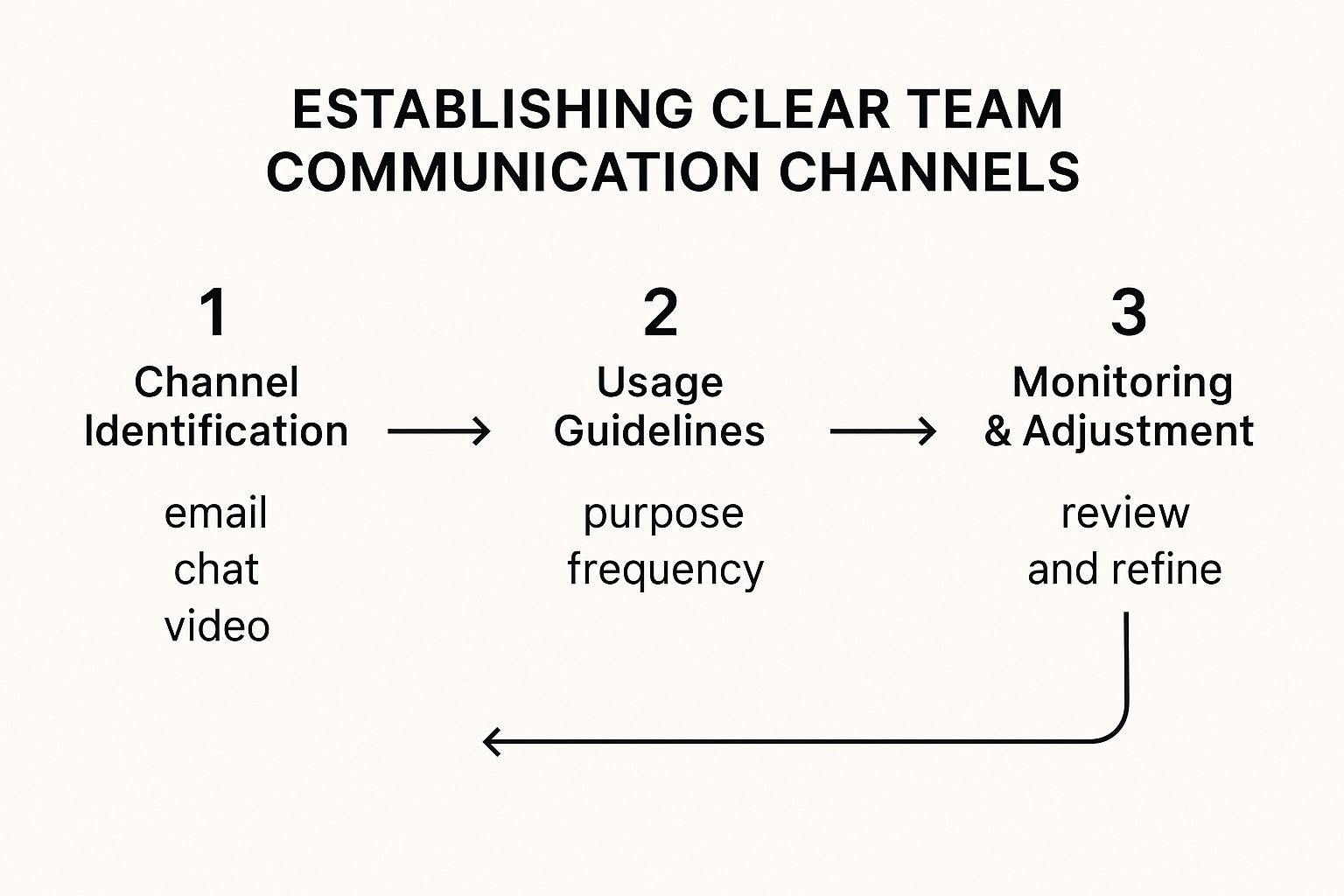Let's be real—job site communication isn't just a "soft skill." It's the engine that drives your projects. When it runs smoothly, everything clicks. When it breaks down, it costs you dearly in time, money, and safety.
This isn't just about avoiding frustration. It's about building a rock-solid operational advantage that directly impacts your bottom line.
Why Job Site Communication Is Your Biggest Untapped Asset
We've all been there. A missed call leads to the wrong materials being delivered. A vague text results in hours of rework. These aren't just one-off headaches; they're symptoms of a bigger problem that quietly drains your profits and damages your reputation.
Getting your communication dialed in is what separates the pros from the amateurs. It’s the key to boosting productivity, slashing mistakes, and making sure everyone on site is safe and on the same page.
The Real Cost of Unclear Communication
Think about the last time a job went sideways. Chances are, a communication breakdown was at the root of it. Maybe a plumber had to guess which fixture to install because the work order was missing a model number. That's a recipe for an expensive do-over.
Or maybe an HVAC tech spotted a serious framing issue but had no clear way to flag it to the project manager. A small problem that could've been a quick fix suddenly becomes a major delay for everyone. These aren't just "oops" moments; they're costly failures that stack up.
Ineffective communication is a silent killer of projects. A staggering 86% of employees and executives point to poor collaboration as a primary reason for workplace failures. It’s not just an annoyance; it's a systemic risk.
Turning Communication into a Competitive Advantage
Here's the good news: fixing your communication process is one of the highest-impact investments you can make, and it doesn't require a six-figure budget.
It starts with a simple mindset shift: treat communication as a critical tool, just like a high-quality power drill. The data backs this up. Teams that nail their communication can see productivity jump by as much as 25%. That's not just a marginal gain; it's a game-changer that transforms a crew of individuals into a coordinated, high-performing force. You can dig into more communication statistics to see just how big the impact is.
Before we dive into the "how," let's pinpoint the exact problems we're solving. Most on-site issues stem from a handful of recurring communication breakdowns.
Common Job Site Communication Breakdowns and Their Fixes
This table outlines the frequent communication failures that plague trades teams and previews the practical, actionable solutions we're about to cover in this guide.
Recognize any of those? If so, you're in the right place. Let's get these issues fixed for good.
Build a Routine with Daily Huddles and End-of-Day Syncs

The best trades teams I’ve ever seen don't run on chaos; they run on a steady, predictable rhythm. On a hectic job site, that predictability is your best friend. The easiest way to build it? Start and end every day with a structured check-in.
These aren't about adding more meetings to an already packed schedule. It's about swapping guesswork and crossed wires for genuine clarity. When you nail this routine, you create a solid framework where information just flows, ensuring everyone starts their shift on the same page and clocks out knowing exactly where things stand.
The Morning Huddle (or Toolbox Talk)
Let's be clear: a morning huddle shouldn't be a long, drawn-out affair where everyone sips coffee and stares at the clock. Keep it short and sharp—a 10 to 15-minute standing meeting to kick off the day. The whole point is to get everyone aligned and zeroed in on the immediate tasks, not to solve every problem before the tools even come out.
A solid morning huddle hits three key points:
- Today’s Mission: What are the top 1-3 absolute priorities for each person or crew today? This defines what a successful day looks like.
- Heads-Up on Hurdles: Is anyone waiting on materials? Need a hand from another trade? This is where you flag those dependencies before they grind everything to a halt.
- Quick Safety Check: Are there any new hazards on site today? A quick reminder keeps everyone’s head in the game and avoids complacency.
It's amazing what a few minutes of alignment in the morning can do. You can head off hours of confusion later on. In fact, teams that really nail their communication can see productivity jump by as much as 25%. This simple habit is a huge part of that.
Don't Skip the End-of-Day Sync
Just as critical as the morning kick-off is the end-of-day sync. This is your chance to close the loop on what actually got done and set the stage for a smooth start tomorrow. It doesn’t have to be a formal meeting—a quick chat at the truck or a few quick messages in your team’s WhatsApp group is all it takes.
Picture an HVAC crew on a commercial project. The lead tech can wrap up the day like this:
- Ductwork Crew: "Second-floor rough-in is complete. We're ready for the third-floor layout, but we're almost out of 8-inch flex duct."
- Controls Tech: "All thermostats on the first floor are in, but room 105 was locked. Need the site manager to open it for me first thing."
In that quick exchange, the project manager learns they need to order more duct, and the site manager gets a heads-up about room 105. That simple, two-minute sync stops the crew from showing up the next morning unable to work. It’s a textbook example of shifting from reactive firefighting to proactive planning.
Define Your Channels for Clearer On-Site Communication
Let's be honest. Have you ever seen a critical safety alert get completely buried in a group chat filled with lunch orders and weekend plans? I’ve seen it happen more times than I can count. When every message—from the truly urgent to the totally trivial—lands in the same place, you're not just creating noise. You're creating real risk on the job site.
It's a natural problem. Without clear guidelines, your crew will use whatever is easiest, not what's most effective. This is how a project manager ends up scrolling through dozens of personal texts, hunting for a photo of that finished installation. It's why a crew member misses a last-minute schedule change—it was posted right after a flurry of memes and got lost in the shuffle. Bringing order to this chaos is one of the most impactful things you can do to improve your workflow.
This isn’t about more meetings or more red tape. It’s about being intentional.

As you can see, the path to better communication starts with one simple step: deciding what tool to use for what job and getting everyone to stick to the plan.
A Simple Framework for Channel Clarity
The goal here isn't to build some complex, bureaucratic system that no one follows. It's about establishing simple, common-sense rules for the road. Think of it like dedicated lanes on a highway—one for fast-moving traffic, one for trucks, one for exiting. Each lane has a purpose, and that’s what keeps things moving smoothly and prevents pile-ups.
Here's a practical example of what this could look like for your team:
- Urgent & Critical Issues: This is for anything that could stop work or pose an immediate safety risk—think a potential gas leak, a structural hazard, or an injury. The rule is simple: this requires an immediate phone call. No texts, no messages. Period.
- Project Progress & Documentation: This bucket is for daily check-ins, site photos, material requests, and client-facing updates. This stuff needs to be documented and easy to find later. A dedicated project management tool that feels familiar, like Nora's WhatsApp integration, is perfect. It gives you an organized, searchable record without forcing your team to learn a complicated new app.
- General Team Coordination: This is your spot for non-urgent announcements, confirming tomorrow's start time, or quick questions that don't need a permanent record. A general team chat group on WhatsApp works great for this kind of daily chatter.
The big idea is to create a simple playbook for how your team talks. When you agree on what goes where, you eliminate the guesswork and cut down on everyone's frustration. In fact, research shows that teams with clear communication protocols can boost their productivity by up to 25%, mostly because they stop wasting time hunting for information.
Getting Your Team on Board
Once you've defined these channels, consistency is everything. You have to lead by example.
If a team member texts you a project photo, your response should be a gentle redirect. Something like, "Thanks, this looks great! Can you pop that into the project's WhatsApp channel so we have it on record?"
This isn’t about being the "communication police." It’s about coaching a better habit across the entire team. It takes the mental load off of everyone trying to figure out how to send a message, and it ensures the important stuff always ends up exactly where it needs to be, ready for action.
Mastering Clear Instructions to Eliminate Rework

On any job site, unclear instructions are a silent killer of your bottom line. I’ve seen it a hundred times—vague directions lead directly to costly rework, frustrating delays, and a crew that’s always looking over its shoulder. The real key to better communication isn't just telling people what to do.
It’s about giving directions that are so clear, they’re almost impossible to get wrong. This means moving from a quick verbal request to a precise, actionable instruction that leaves no room for doubt.
The fallout from ambiguity is huge. It's not just about wasted materials; it's about the stress it puts on your team. A staggering 80% of workers report feeling stressed because of poor company communication. For 46% of employees, confusing instructions are a regular part of their day. They end up wasting around 40 minutes every day just trying to figure out what they’re supposed to do. You can dig into more of these teamwork statistics and their impact to see how deep this problem runs.
The Anatomy of a Foolproof Instruction
To make your directions stick, you need to cover all the bases. I've always found it helpful to think in terms of four simple questions: what, where, when, and how. Running through this mental checklist before you give an order ensures you're providing the complete picture.
Think about the difference here:
- Vague: "Hey, can you get the light fixtures installed in the main office?"
- Clear: "I need you to install the five Model #34B pendant lights in the main office ceiling grid. Make sure they're spaced six feet apart, starting from the east wall. This has to be done by the end of the day because the painters are scheduled for first thing tomorrow. The exact layout is on page 7 of the electrical plan."
The first example is an open invitation for questions and mistakes. The second one gives your team everything they need to get it right the first time, with no guesswork.
A great instruction doesn't just tell someone what to do; it paints a complete picture of the finished task. This includes the specifics, the timeline, and any resources they need to get it right the first time.
Make It Safe to Ask Questions
Here’s the thing—even the most perfectly worded instructions can land differently for different people. That’s why the absolute most important part of this is creating an environment where your crew feels totally comfortable asking for clarification. No one should ever feel stupid for asking a question.
How you open the floor for questions matters more than you think. A closed-off question like, "Any questions?" almost always gets a quick "nope."
Instead, try asking this:
"What questions do you have for me?"
This small change in phrasing does something powerful. It assumes there will be questions, which makes it normal to ask them. It shifts the entire dynamic from a pop quiz to a genuine effort to get everyone on the same page. This is probably one of the most effective habits any crew leader can build.
Close the Loop to Confirm Understanding
To really nail it down, I always use a quick confirmation loop. After you’ve given the instructions and answered any questions, ask someone to repeat the key points back to you.
It doesn’t have to be a big production. Just something simple like: "Alright, just so we’re on the same page, can you quickly walk me through the first couple of steps?"
This isn't about micromanaging them. It’s a final gut check to make sure the message you sent is the one they received. It’s your last line of defense against rework and sends everyone off to do the job with confidence.
Using Tech to Bridge the Field and the Office
Your crew in the field is the lifeblood of your operation, but they’re often the most disconnected from the main office. This isn't just a communication hiccup; it's a gap where mistakes, delays, and serious frustrations are born. We've all seen projects go sideways because the person on-site saw one thing while the office planned for another.
The answer isn’t throwing some clunky, over-engineered software at them that takes a week to learn. The real breakthrough comes from using smart, simple tech that plugs right into how your crew already operates. It’s about meeting them where they are to finally get information flowing smoothly both ways.
Choose Tools That Your Crew Will Actually Use
Let's be honest: if it's a pain to use, your field team won't use it. The secret to getting everyone on board is picking technology that feels familiar, not like another chore tacked onto their day. This is where tools that integrate with apps they already have on their phones, like WhatsApp, are so effective.
This simple approach completely sidesteps the steep learning curve that kills most new software rollouts.
Think about it. When a tech can snap a photo of an issue, record a quick voice note, or fire off a text from the job site—and that info instantly gets organized for the office—you've solved a massive problem. No new app to download, no confusing menus to navigate. It just works.
Imagine a plumber on a call who finds an unexpected corroded pipe behind a wall. Instead of a garbled phone call trying to explain the situation, they can just:
- Shoot a quick video of the damage and send it through WhatsApp.
- Record a voice note explaining what new parts are needed and how much extra time it'll take.
- Get a go-ahead from the project manager in minutes, with a clear record of the approval.
That whole interaction is over and done in less than 60 seconds. The PM has a crystal-clear visual, and the plumber gets the green light without wasting time. That's how you empower your team.
It's easy to forget how disconnected non-desk workers can feel. An international study looking ahead to 2025 revealed that a staggering 34% of these employees feel their concerns are either poorly addressed or flat-out ignored by management. Giving them a direct, simple line of communication is the first step to closing that gap. You can dig deeper into these findings on leadership communication.
Create a Single, Reliable Source of Information
Here’s where this approach gets really powerful. When all those field updates are captured through a dedicated tool like Nora, every photo, voice note, and text message is automatically transcribed, tagged, and organized into one central hub.
This is a game-changer for your office staff. They no longer have to hunt down technicians for updates, chase after timesheets, or try to make sense of handwritten notes on a work order. Instead, they have a live, searchable log for every single job.
This streamlined flow of information pays off in huge ways:
- Quicker Billing: When logs of materials and labor are instantly available and accurate, you can get invoices out the door faster.
- Rock-Solid Documentation: You automatically build a complete, time-stamped history of every project, which is pure gold for resolving client disputes or reviewing past work.
- Smarter Project Oversight: The office team can see the real-time status of every job without having to constantly call or text the field crew for updates.
By connecting your field and office with technology that’s both incredibly simple and powerful, you’re doing more than just improving communication. You're building a smarter, more profitable, and less chaotic operation from the ground up.
Your Questions on Trades Team Communication Answered

Putting new communication habits into practice always brings up a few real-world questions. It’s one thing to talk about these strategies in the office, but it's a completely different story trying to make them work on a busy, noisy job site. Let's tackle some of the most common hurdles I've seen teams face and get you some direct, no-nonsense answers to help make these improvements stick.
How Do I Get Older, Less Tech-Savvy Crew Members On Board?
This is probably the most common question I get, and it’s a fair one. But trust me, it’s entirely solvable. The secret is to focus on simplicity and answer the unspoken question on their minds: "What's in it for me?" Nobody, especially a seasoned pro, wants to learn a complicated new system just for the sake of it.
Start by choosing tools that feel familiar. For instance, a platform that works right inside WhatsApp is a game-changer because it removes the biggest barrier—most people already know how to use it. There's no new app to download or password to remember.
Don't just tell them about the tool; show them how it solves a specific headache they deal with every single day.
Walk them through it. Show them how snapping a quick photo to get instant clarification from the office saves them that frustrating 20-minute trip back to the shop just to ask a question. Once they see it solves a real problem, they'll be on board. A great tactic is to pair a tech-friendly team member with someone who's a bit more resistant. When they see the benefits firsthand, the resistance melts away.
What Is the Single Biggest Communication Change We Can Make Today?
If you do only one thing after reading this, do this: start a structured, non-negotiable daily huddle. It’s the foundational habit that everything else gets built on. Seriously.
A consistent 10-minute check-in at the start of the day to go over priorities, flag potential safety issues, and identify obstacles can prevent countless hours of confusion and rework. It establishes a rhythm of proactive communication and ensures everyone is on the same page before the first nail is hammered. This one simple act can shift your entire team's mindset from reactive problem-solving to proactive planning.
The most effective teams aren’t just better at their trade; they’re better at talking about their trade. A daily huddle is the single most powerful way to build that muscle. It forces clarity and surfaces problems when they are still small and easy to solve.
Our Communication Seems Fine, So Why Change It?
This is a tricky one, because communication problems rarely show up on a spreadsheet labeled "communication problems." Instead, they disguise themselves as other issues you’re already fighting every day.
Think about these common pain points you're likely all too familiar with:
- Unexpected rework that blows the budget.
- Minor safety incidents that could have easily been much worse.
- Project delays because materials weren't ordered on time.
- Client frustration over misunderstandings or unmet expectations.
Each one of these issues almost always has a communication failure at its core. What seems "fine" might actually be hiding significant inefficiencies that are quietly costing you money and holding your team back. Improving how your crew communicates isn't just about fixing what's obviously broken. It's about unlocking a higher level of performance, safety, and profitability that you might not even realize is possible.
Ready to stop chasing down details and start getting clean, organized job notes instantly? See how Nora uses the power of AI and the simplicity of WhatsApp to transform your field communication. Explore Nora today and give your team the tool they'll actually use.



